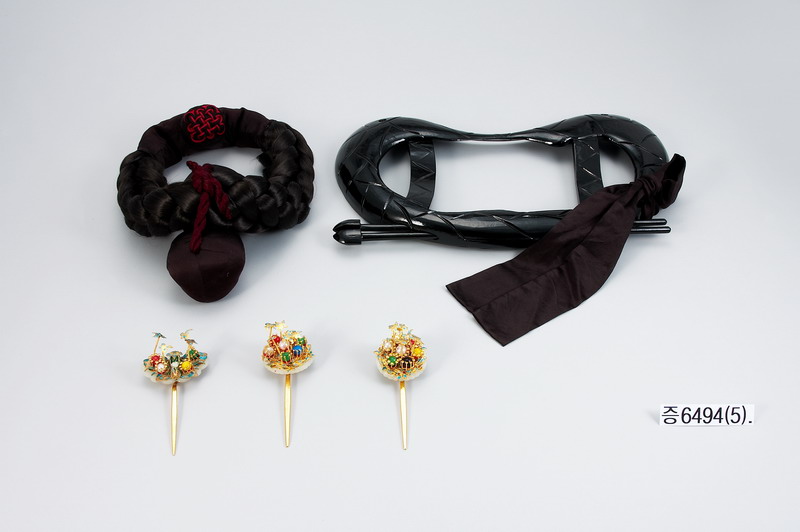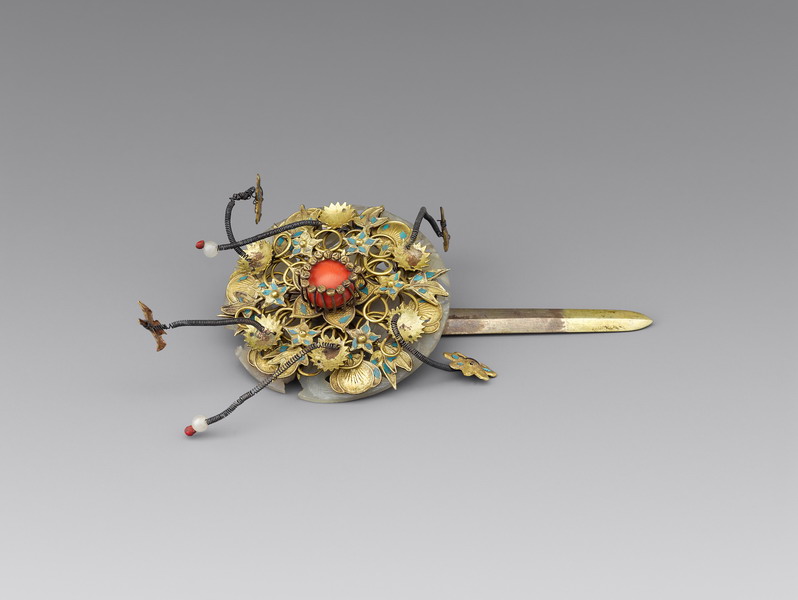The Confucianization of Women’s Hairstyles in Joseon Korea
By Diane Dooley
Korean society became increasingly dominated by neo-Confucian ideology during the Joseon Dynasty as it shook off the sociocultural inheritance from the preceding, mainly Buddhist, Goryeo Dynasty. This process of Confucianization eventually seeped into every aspect of society – including dress and hairstyles. Neo-Confucianism as practiced during the Joseon Dynasty is broadly characterized by the maintenance of a strict social hierarchy in which relationships were inherently unequal.
The five main neo-Confucian relationships were between: man and wife, father and son, king and subject, elders and younger people, and friends. In addition, age, marital status, and occupation were important markers of one’s relative place in society during the Joseon Dynasty. These social status boundaries became so important that they were reflected in almost every aspect of social behavior, including how one dressed and styled one’s hair.
As noted in my previous article on men’s hairstyles during the Joseon Dynasty, “The Land of Hats” (September 2021), this was a gradual process. Customs and traditions from the preceding Goryeo Dynasty did not disappear overnight, nor did people always accept new regulations on dress enthusiastically. Fashion trends and personal preferences often took precedence over social expectations and government regulations. This was especially true of women’s hairstyles and accessories, which were the topic of intense debate in court throughout the Joseon Dynasty.

Inner Quarters, Outerwear
Just as there were a variety of hairstyles and headwear available for men, there were many available for women, too. If you have ever watched a historical Korean drama, you will be familiar with images of women in colorful hanbok
(한복), with their long hair tied back in elegant braids, often decorated with dazzling hairpins; the elaborate wigs worn by queens; or even the large ribbons worn by court ladies. One thing you are unlikely to have seen, though, is the leading lady covered from head to toe by a veil!
The gradual growth of neo-Confucianism in Joseon had particularly severe consequences for women. Their movement became more restricted as they became confined to the domestic sphere – that is, the family home. Neo-Confucian legislation during the Joseon Dynasty was concerned with correcting “corrupt female mores,” argued (in the ideological transition) to have been inherited from the preceding Goryeo Dynasty and its religious ideology, Buddhism. It was argued by Confucian-supporting officials that the indiscriminate use of fabrics and styles – that is, women dressing more or less as they pleased – had blurred the lines between social status groups and demanded restraint, frugality, and modesty. For men, to be properly dressed reflected their gentlemanly decorum; for women, however, it was linked to their feminine virtue and modesty.
A variety of veils were developed to achieve the legislators’ goals of limiting women’s participation in the public sphere of life. During the early years of the Joseon Dynasty, noblewomen wore black sheer silk veils known as neoul (너울). This was a large hat with a veil attached. It covered a woman’s body from her head to waist. As neo-Confucianism gained prominence, women’s outdoor activities became more and more restricted depending on one’s social status. However, when women did venture outside, they were required to cover their faces, and this required the development of appropriate outerwear.
Women of high social status generally traveled by palanquin – another way in which their visibility was limited – so they favored veils known as the sseugaechima (쓰개치마) and jangot (장옷), as they were practical and easier to carry and store compared to the neoul. The jangot was similar to a man’s overcoat, the durumagi (두루마기), fastened by buttons and breast ties. The sseugaechima was similar to women’s skirts in shape, but longer. The veil had an attached band, similar to a waistband.
Women’s veils appear to be less about covering their hair than the men’s gat and more about keeping their participation in society to a minimum in order to ensure they “maintained their virtue.” The restrictive clothing they were required to wear naturally curtailed their participation in the public sphere. However, this mainly applied to women of yangban status – women from lower social status groups were not required to cover their faces. Instead, they wore simple head cloths for everyday use.
Wigs in Vogue
Women’s hairstyles and hair accessories were a frequent topic of debate in court in the mid-Joseon Dynasty, particularly during the reign of King Yeongjo (1724–1776). The restoration of Confucian ideals was his guiding principle, and he used sumptuary laws to achieve this. These laws regulated one’s housing, clothing, accessories, and even mode of transport according to social status. Confucian lawmakers believed that the mark of a civilized society was one in which people lived within their limits and privileges, as it would prevent them from “falling into excess.” They promoted austerity and frugality and prohibited luxuriousness and ostentatiousness.

One of the most popular trends in women’s hair regardless of social status had been the use of wigs known as gache (가체) and large hairpieces. These were usually made from horsehair – but also sometimes human hair – and were worn over the typical chignon hairstyle. Wealthy married women and members of the royal family wore the largest, most elaborate wigs. The gisaeng (기생), a group of low-status, government-indentured, entertainers/prostitutes were also known for their use of large, elaborate wigs. The “luxuriousness” and lack of propriety these wigs were seen to reflect were a major issue in court. Significantly, it was argued that wearing another person’s hair on one’s head was particularly lacking in propriety. As one’s hair was linked to his or her own ancestors, and therefore a tangible manifestation of one’s filial piety, it was abhorrent to Confucian purists that someone would wear someone else’s hair on their head as decoration.
These large, elaborate headdresses were anything but austere: They were extremely expensive. It was claimed that they had become so expensive that people were falling into debt in order to buy them. It was therefore essential to “eliminate luxuriousness” and prevent people “squandering” their money, and so the use of wigs was banned.
However, the prohibition on wigs was not entirely successful: Many women from both established families as well as gisaeng continued to wear them. The Confucian demand for austerity – even when enforced through the Joseon legal system – was not enough to curb the popularity of wigs.
Pinning It
Towards the end of the Joseon Dynasty, large wigs made of false hair were gradually replaced as the hairdo of choice by tightly bound chignon hairstyles decorated with simpler ornaments as various prohibitions and regulations were implemented. Subsequently, the hairpins used to secure the chignon became the focus of women’s hairstyles.

A variety of hairpins were available for women to use, such as the binyeo (비녀), a stick-like hairpin with a head on one end. These pins were inserted through the chignon to hold it in place. There were various types of binyeo. Just as there were different hats for men for different occasions, binyeo varied in size, material, and color depending on the wearer’s social status or occasion. Typically, short hairpins were used for everyday activities and longer ones were used for ceremonial use. Although there were no strict rules governing the materials used for binyeo based on the wearer’s social status, only upper-class women, or very wealthy commoners, were able to afford more luxurious binyeo made from expensive materials. We are all familiar with the seasonal, cyclical nature of fashion that exists today. Joseon Korea was similar. Jade was typically worn in the summer; gold, silver, or coral binyeo were preferred for the winter.
Conclusion: The Virtuous Hairdo
Unlike men, it does not appear to be the case that women’s hair functioned as a conspicuous symbol of filial piety for which they were willing to die rather than cut or wear loose. According to Confucianism, a daughter’s filial piety was less important than a son’s. A daughter’s duty was to join another family, be loyal to her husband, and bear male offspring for that family, which perhaps gave her more freedom to experiment with wigs and hairpieces before the reign of Yeongjo. As neo-Confucianism gained prominence, women became increasingly oppressed and confined to the domestic sphere under the precedence of “protecting their virtue.” Women’s hairstyles evolved from elaborately decorated hairpieces to minimalist, tightly bound chigons as their place in society became more restricted. Their tightly bound hairstyles reflected their tightly bound lives.
Sources
Deuchler, M. (1992). The Confucian transformation of Korea. Council on East Asian Studies, Harvard University.
Kim, Y., & Pettid, M. J. (2011). Women and Confucianism in Chosŏn Korea. State University of New York Press.
Haboush, J. K. (2001). The Confucian kingship in Korea. Columbia University Press.
Kim, Y. (1976). Women of Korea. Ewha Womans University Press.
Lee, K. J., Hong, N., Chang, S., & Yi, M. (2005). Traditional Korean costume. Global Oriental.
Nelson, S. M. (1998). Bound hair and Confucianism in Korea. In A. Hiltebeitel & B. D. Miller (Eds.). Hair: Its power and
meaning in Asian cultures (pp. 105–122). State University of New York Press.
Yeongjo sillok [Veritable records of King Yeongjo]. (1724–1776). In Joseon wangjo sillok [조선왕조실록, 朝鮮王朝實錄,
Veritable records of the Joseon Dynasty]. National Institute of Korean History.
The Author
Diane Dooley is originally from Glasgow, Scotland, and has a BA in Korean and an MA in Korean literature. She enjoys reading, coffee, and talking about Korea to anyone willing to listen. She currently lives and works in Gwangju as an English teacher and is passionate about education. E-mail: dianedooley@naver.com







